
(a)
Interpretation:
Bond-line structure for the given set of amino acids in zwitterionic form need to be drawn.
Concept introduction:
Bond-line structure is the representation of organic structural formulas in a shorthand manner. In this case only the bond between carbon and other atoms are shown except hydrogen. It is understood that all the remaining valency to be filled by hydrogen. Apart from carbon atoms the other atoms are shown along with hydrogen.
Zwitterion is the one which has the positively and negatively charged groups separately. Zwitterion is found at the pH which is the isoelectric point.
To draw : To draw bond-line structure for L-valine
(a)
Answer to Problem 40PP
The bond-line structure for (a) and its zwitterion form is
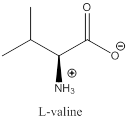
Explanation of Solution
Linear formula for L-valine
The linear formula for L-valine is
Draw bonds between the atoms except hydrogen

The structure from the linear formula is drawn as shown above. Considering the valency of carbon to be four, the structure is drawn.
Remove the carbons that are explicitly shown

The carbon atoms are ignored from being explicitly shown as it is understood that the carbon and hydrogen atoms are not shown in bond-line structure.
Assign configuration

As in the name of the problem statement it is said L-valine, the chiral center must have “S” configuration and the same is shown in the above structure.
Zwitterion

Zwitterion is one of the form in which the charge is separated and this is formed at a particular pH known as isoelectric point.
(b)
Interpretation:
Bond-line structure for the given set of amino acids in zwitterionic form need to be drawn.
Concept introduction:
Bond-line structure is the representation of organic structural formulas in a shorthand manner. In this case only the bond between carbon and other atoms are shown except hydrogen. It is understood that all the remaining valency to be filled by hydrogen. Apart from carbon atoms the other atoms are shown along with hydrogen.
Zwitterion is the one which has the positively and negatively charged groups separately. Zwitterion is found at the pH which is the isoelectric point.
To draw : To draw bond-line structure for L-tryptophan
(b)
Answer to Problem 40PP
The bond-line structure for (b) and its zwitterion form is
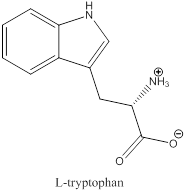
Explanation of Solution
Linear formula for L-tryptophan
The linear formula for L-tryptophan is
Draw bonds between the atoms except hydrogen
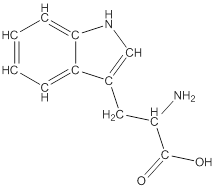
The structure from the linear formula is drawn as shown above. Considering the valency of carbon to be four, the structure is drawn. The benzopyroole ring is the one which is represented as
Remove the carbons that are explicitly shown
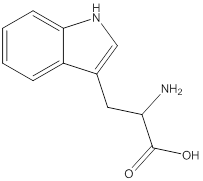
The carbon atoms are ignored from being explicitly shown as it is understood that the carbon and hydrogen atoms are not shown in bond-line structure.
Assign configuration
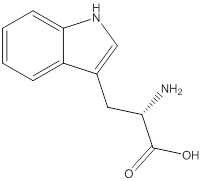
As in the name of the problem statement it is said L-tryptophan, the chiral center must have “S” configuration and the same is shown in the above structure.
Zwitterion
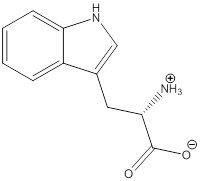
Zwitterion is one of the form in which the charge is separated and this is formed at a particular pH known as isoelectric point.
(c)
Interpretation:
Bond-line structure for the given set of amino acids in zwitterionic form need to be drawn.
Concept introduction:
Bond-line structure is the representation of organic structural formulas in a shorthand manner. In this case only the bond between carbon and other atoms are shown except hydrogen. It is understood that all the remaining valency to be filled by hydrogen. Apart from carbon atoms the other atoms are shown along with hydrogen.
Zwitterion is the one which has the positively and negatively charged groups separately. Zwitterion is found at the pH which is the isoelectric point.
To draw : To draw bond-line structure for L-glutamine
(c)
Answer to Problem 40PP
The bond-line structure for (c) and its zwitterion form is
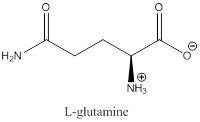
Explanation of Solution
Linear formula for L-glutamine
The linear formula for L-glutamine is
Draw bonds between the atoms except hydrogen

The structure from the linear formula is drawn as shown above. Considering the valency of carbon to be four, the structure is drawn.
Remove the carbons that are explicitly shown

The carbon atoms are ignored from being explicitly shown as it is understood that the carbon and hydrogen atoms are not shown in bond-line structure.
Assign configuration

As in the name of the problem statement it is said L-glutamine, the chiral center must have “S” configuration and the same is shown in the above structure.
Zwitterion

Zwitterion is one of the form in which the charge is separated and this is formed at a particular pH known as isoelectric point.
(d)
Interpretation:
Bond-line structure for the given set of amino acids in zwitterionic form need to be drawn.
Concept introduction:
Bond-line structure is the representation of organic structural formulas in a shorthand manner. In this case only the bond between carbon and other atoms are shown except hydrogen. It is understood that all the remaining valency to be filled by hydrogen. Apart from carbon atoms the other atoms are shown along with hydrogen.
Zwitterion is the one which has the positively and negatively charged groups separately. Zwitterion is found at the pH which is the isoelectric point.
To draw : To draw bond-line structure for L-proline
(d)
Answer to Problem 40PP
The bond-line structure for (d) and its zwitterion form is
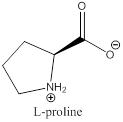
Explanation of Solution
Draw bonds between the atoms except hydrogen
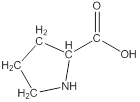
The structure from the linear formula is drawn as shown above. Considering the valency of carbon to be four, the structure is drawn.
Remove the carbons that are explicitly shown
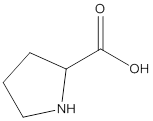
The carbon atoms are ignored from being explicitly shown as it is understood that the carbon and hydrogen atoms are not shown in bond-line structure.
Assign configuration

As in the name of the problem statement it is said L-proline, the chiral center must have “S” configuration and the same is shown in the above structure.
Zwitterion
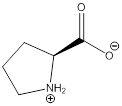
Zwitterion is one of the form in which the charge is separated and this is formed at a particular pH known as isoelectric point.
Want to see more full solutions like this?
Chapter 25 Solutions
Organic Chemistry, Third Edition Binder Ready Version
- Another standard reference electrode is the standard calomel electrode: Hg2Cl2(s) (calomel) + 2e2 Hg() +2 Cl(aq) This electrode is usually constructed with saturated KCI to keep the Cl- concentration constant (similar to what we discussed with the Ag-AgCl electrode). Under these conditions the potential of this half-cell is 0.241 V. A measurement was taken by dipping a Cu wire and a saturated calomel electrode into a CuSO4 solution: saturated calomel electrode potentiometer copper wire CuSO4 a) Write the half reaction for the Cu electrode. b) Write the Nernst equation for the Cu electrode, which will include [Cu2+] c) If the voltage on the potentiometer reads 0.068 V, solve for [Cu²+].arrow_forward2. (Part B). Identify a sequence of FGI that prepares the Synthesis Target 2,4-dimethoxy- pentane. All carbons in the Synthesis Target must start as carbons in either ethyne, propyne or methanol. Hint: use your analysis of Product carbons' origins (Part A) to identify possible structure(s) of a precursor that can be converted to the Synthesis Target using one FGI. All carbons in the Synthesis Target must start as carbons in one of the three compounds below. H = -H H = -Me ethyne propyne Synthesis Target 2,4-dimethoxypentane MeOH methanol OMe OMe MeO. OMe C₂H₁₂O₂ Product carbons' origins Draw a box around product C's that came from A1. Draw a dashed box around product C's that came from B1.arrow_forwardDraw the skeletal ("line") structure of the smallest organic molecule that produces potassium 3-hydroxypropanoate when reacted with KOH. Click and drag to start drawing a structure. Sarrow_forward
- draw skeletal structures for the minor products of the reaction.arrow_forward1. Provide missing starting materials, reagents, products. If a product cannot be made, write NP (not possible) in the starting material box. C7H12O Ph HO H 1) 03-78 C 2) Me₂S + Ph .H OH + 2nd stereoisomer OH Ph D + enantiomer cat OsO 4 NMO H2O acetonearrow_forwardPlease note that it is correct and explains it rightly:Indicate the correct option. The proportion of O, C and H in the graphite oxide is:a) Constant, for the quantities of functional groups of acids, phenols, epoxy, etc. its constants.b) Depending on the preparation method, as much oxidant as the graphite is destroyed and it has less oxygen.c) Depends on the structure of the graphic being processed, whether it can be more tridimensional or with larger crystals, or with smaller crystals and with more edges.arrow_forward
- Check the box under each a amino acid. If there are no a amino acids at all, check the "none of them" box under the table. Note for advanced students: don't assume every amino acid shown must be found in nature. ནང་་་ OH HO HO NH2 + NH3 O OIL H-C-CO CH3-CH O C=O COOH COOH + H2N C-H O H2N C H CH3-CH CH2 HO H3N O none of them 口 CH3 CH2 OH Хarrow_forwardWhat is the systematic name of the product P of this chemical reaction? 010 HO-CH2-CH2-C-OH ☐ + NaOH P+ H2Oarrow_forward1. Provide missing starting materials, reagents, products. If a product cannot be made, write NP (not possible) in the starting material box. a) C10H12 Ph OMe AcOHg+ + enantiomer Br C6H10O2 + enantiomerarrow_forward
 ChemistryChemistryISBN:9781305957404Author:Steven S. Zumdahl, Susan A. Zumdahl, Donald J. DeCostePublisher:Cengage Learning
ChemistryChemistryISBN:9781305957404Author:Steven S. Zumdahl, Susan A. Zumdahl, Donald J. DeCostePublisher:Cengage Learning ChemistryChemistryISBN:9781259911156Author:Raymond Chang Dr., Jason Overby ProfessorPublisher:McGraw-Hill Education
ChemistryChemistryISBN:9781259911156Author:Raymond Chang Dr., Jason Overby ProfessorPublisher:McGraw-Hill Education Principles of Instrumental AnalysisChemistryISBN:9781305577213Author:Douglas A. Skoog, F. James Holler, Stanley R. CrouchPublisher:Cengage Learning
Principles of Instrumental AnalysisChemistryISBN:9781305577213Author:Douglas A. Skoog, F. James Holler, Stanley R. CrouchPublisher:Cengage Learning Organic ChemistryChemistryISBN:9780078021558Author:Janice Gorzynski Smith Dr.Publisher:McGraw-Hill Education
Organic ChemistryChemistryISBN:9780078021558Author:Janice Gorzynski Smith Dr.Publisher:McGraw-Hill Education Chemistry: Principles and ReactionsChemistryISBN:9781305079373Author:William L. Masterton, Cecile N. HurleyPublisher:Cengage Learning
Chemistry: Principles and ReactionsChemistryISBN:9781305079373Author:William L. Masterton, Cecile N. HurleyPublisher:Cengage Learning Elementary Principles of Chemical Processes, Bind...ChemistryISBN:9781118431221Author:Richard M. Felder, Ronald W. Rousseau, Lisa G. BullardPublisher:WILEY
Elementary Principles of Chemical Processes, Bind...ChemistryISBN:9781118431221Author:Richard M. Felder, Ronald W. Rousseau, Lisa G. BullardPublisher:WILEY





